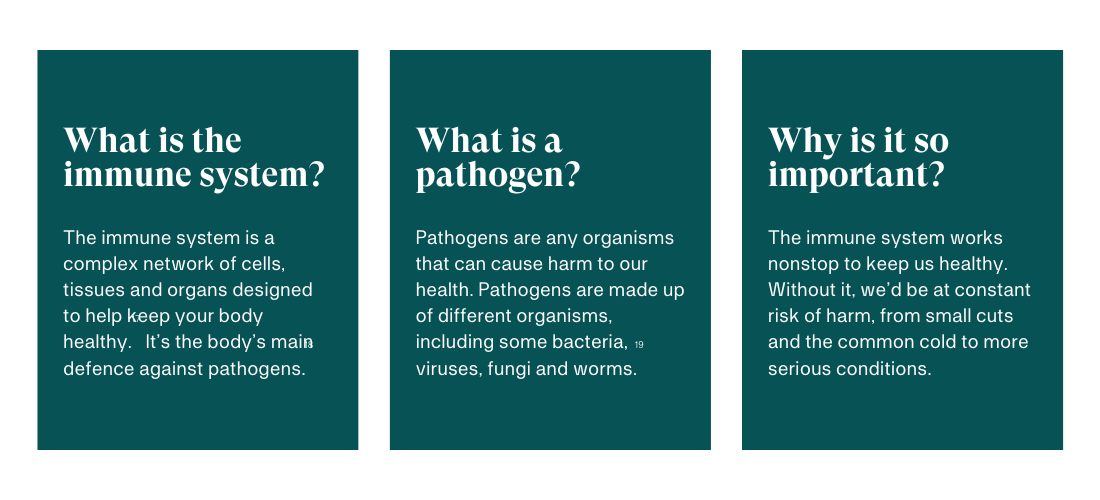At Tate & Lyle, we continue to build on our 160 years of experience, and through research and innovation, we’re learning a lot about the various potential health benefits of PROMITOR® Soluble Fibre for consumers and how it can positively impact the future of food.
The potential health benefits of PROMITOR® Soluble Fibre include* supporting calcium absorption and bone calcium retention, potentially contributing to bone health,1-4 supporting gastrointestinal health,5-7 a good digestive tolerance,8-10 , and maintaining healthy post-meal blood glucose levels (when used to substitute sugar or other digestible carbohydrates).11-14
Some of the most exciting emerging data suggest that PROMITOR® Soluble Fibre could have a beneficial effect on the immune system*.2,6,15,16 To understand the link between PROMITOR® Soluble Fibre and the immune system, it’s good first to have an overview of what the immune system is, why it’s important, and the different factors that can affect how it works.
What affects the function of the immune system?
A lot of things can affect how the immune system works and how effectively it functions to keep us healthy. Some of these factors are completely out of our control, for instance: genetics, age, or illnesses we’ve already experienced and ongoing chronic illness. However, some factors are in our control, such as how much we exercise, the choices we make about vaccinations, stress levels, smoking and alcohol intake, or diet.
Dietary fibre and immune health
In order to function as they should, the cells in the immune system require nutrients that are present in the food we eat. There’s a wealth of research out there into the health benefits of eating more dietary fibre,1-5 and it’s been shown to
-
Help with managing caloric intake for healthy weight management (when used to substitute sugar or other digestible carbohydrates)
-
Support cardiovascular health
-
Temper spikes in blood sugar levels (after meals)
-
Promote a healthy gut
In addition, a diet high in fibre can help to reduce the risk of certain diseases, including diabetes, some cancers and heart disease.20-22 Despite this, the fibre intake of the global general population falls well below the recommended levels.21
Bridging the fibre gap to help support immune health
Consumers already understand the importance of dietary fibre. That’s why they’re already actively looking across various food and beverage categories for products that can easily help them increase their fibre intake. Adding PROMITOR® Soluble Fibre to the products consumers enjoy is a simple way to bridge the fibre gap without increasing their calorie content (when used to substitute sugar or other digestible carbohydrates) or affecting their taste and texture.
Innovating for the future of nutrition
Since the COVID-19 pandemic, consumers have an increased awareness of immune health, and attitudes have shifted to focus on how it can be improved.26 Helping consumers to increase their fibre intake ensures products are meeting consumer needs - which is vital in today’s marketplace.
As we continue to discover more about the true impact of dietary fibre on health, from prebiotic benefits to potentially supporting the immune system, we understand more about the importance of innovation in nutrition that allows consumers to easily increase their fibre intake without compromising the taste and texture of products they love.
That’s what makes PROMITOR® Soluble Fibre the extraordinary ingredient for everyday life, for today and the future.
Note: References provided at the bottom of this page.

PROMITOR® Soluble Fibre
PROMITOR® Soluble Fibre meets consumer demands for digestive tolerance, taste and texture and, depending on country, enables manufacturers to make a variety of fibre content claims and health benefit claims.
Reference List
1. Weaver CM, et al. 2010. Novel fibers increase bone calcium content and strength beyond efficiency of large intestine fermentation. J Agric Food Chem. 25;58(16):8952-7.
2. Whisner CM, et al. 2014. Soluble maize fibre affects short-term calcium absorption in adolescent boys and girls: a randomised controlled trial using dual stable isotopic tracers. Br J Nutr. 112:446-56.
3. Whisner CM, et al. 2016. Soluble corn fiber increases calcium absorption associated with shifts in the gut microbiome: a randomized dose-response trial in freeliving pubertal females. J Nutr. 146:1298-306.
4. Jakeman SA, et al. 2016. Soluble corn fiber increases bone calcium retention in postmenopausal women in a dose-dependent manner: a randomized crossover trial. Am J Clin Nutr. 104:837-43.
5. Arroyo MC, et al. 2023. Age-dependent prebiotic effects of soluble corn fiber in M-SHIME® gut microbial ecosystems. Plant Foods Hum Nutr. Mar;78(1):213-220.
6. Vester Boler BM, et al. 2011. Digestive physiological outcomes related to polydextrose and soluble maize fibre consumption by healthy adult men. Br J Nutr. 106:1864-71.
7. Timm DA, et al. 2013. Polydextrose and soluble corn fiber increase five-day fecal wet weight in healthy men and women. J Nutr. 143(4):473-8.
8. Sanders L, et al. 2008. A novel maize-based dietary fiber is well tolerated in humans. FASEB J.22:lb761.
9. Stewart ML, et al. 2010. Evaluation of the effect of four fibers on laxation, gastrointestinal tolerance and serum markers in healthy humans. Ann Nutr Metab. 56(2):91-8.
10. Housez B, et al. 2012. Evaluation of digestive tolerance of a soluble corn fibre. J Hum Nutr Diet. 25(5):488-96.
11. Canene-Adams K, et al. 2021. A randomized, double-blind, crossover study to determine the available energy from soluble fiber. J Am Coll Nutr. 40(5):412-418.
12. Canene-Adams K, et al. 2022. Estimating the potential public health impact of fibre enrichment: a UK modelling study. Br J Nutr. 128(9):1868-1874.
13. Cervantes-Pahm SK, et al. 2009. Digestible energy in resistant starch and dietary fiber sources fed to pigs. J. Anim. Sci. 87, E-Suppl. 2.
14. Fastinger ND, et al. 2007. Glycemic response and metabolizable energy content of novel maize-based soluble fibers F4-809, F4-810 and F4-810LS using canine and avian models. FASEB J. 21:A744.
15. Costabile A, et al. 2017. Effects of soluble corn fiber alone or in synbiotic combination with Lactobacillus rhamnosus GG and the pilus-deficient derivative GGPB12 on fecal microbiota, metabolism, and markers of immune function: a randomized, double-blind, placebocontrolled, crossover study in healthy elderly (saimes study). Front Immunol. 12;8:1443.
16. Costabile A, et al. 2016. Prebiotic potential of a maizebased soluble fibre and Impact of dose on the human gut microbiota. PLoS One. 5;11(1):e0144457.
17. Marshall JS, et al. 2018. An introduction to immunology and immunopathology. Allergy Asthma Clin Immunol. 12;14(Suppl 2):49.
18. InformedHealth.org [Internet]. Cologne, Germany: Institute for Quality and Efficiency in Health Care (IQWiG). 2006. The innate and adaptive immune systems. [Updated 2020 Jul 30]. Available from: https://www.ncbi.nlm.nih.gov/books/NBK279396/
19. Alberts B, et al. 2002. Molecular Biology of the Cell. 4th edition. New York: Garland Science. Introduction to pathogens. Available from: https://www.ncbi.nlm.nih.gov/books/NBK26917/
20. Institute of Medicine, Food and Nutrition Board. 2002/2005. Dietary Reference Intakes: energy, carbohydrates, fiber, fat, fatty acids, cholesterol, protein and amino acids. Washington, DC: National Academies Press.
21. Stephen AM, et al. 2017. Dietary fibre in Europe: current state of knowledge on definitions, sources, recommendations, intakes and relationships to health. Nutr Res Rev. 30(2):149-190.
22. Dietary Guidelines Advisory Committee. 2015. Report of the dietary guidelines advisory committee on the dietary guidelines for Americans.
23. Schley PD, Field CJ. 2002. The immune-enhancing effects of dietary fibres and prebiotics. Br J Nutr. 87 Suppl 2:S221-30.
24. Venter C, et al. 2022. Role of dietary fiber in promoting immune health-an EAACI position paper. Allergy. 77(11):3185-3198.
25. Maathuis A, et al. 2009. The effect of the undigested fraction of maize products on the activity and composition of the microbiota determined in a dynamic in vitro model of the human proximal large intestine. J Am Coll Nutr. 28(6):657-66.
26. Das D, et al. 2022. Impact of COVID-19 on changing consumer behaviour: lessons from an emerging economy. Int J Consum Stud. 46(3):692-715
Disclaimer: This data, research, and product information (“content”) is published for your consideration and independent verification. Tate & Lyle accepts no liability for accuracy or completeness of this content. We may change this content at any time. The applicability of label claims and the regulatory and intellectual property status of this content and our ingredients varies by jurisdiction. You should obtain your own advice regarding all legal and regulatory aspects of this content and our ingredients and their usage in your own products to determine suitability for their particular purposes, claims, freedom to operate, labelling or specific applications in any particular jurisdiction.

